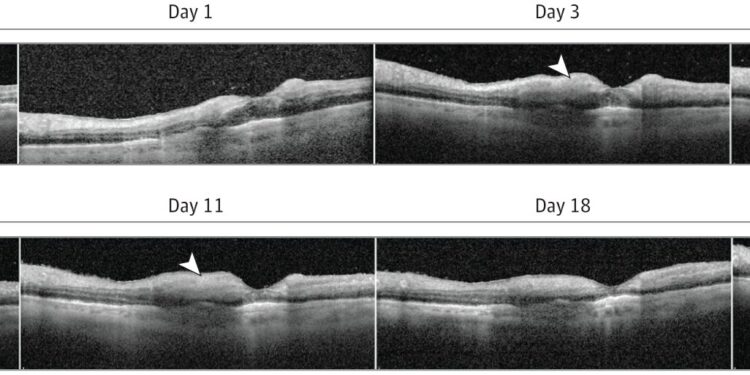The series of B-scans passing through the fovea shows macular changes over time, starting with initial swelling including intraretinal fluid (white arrow), progressing to hyperreflectivity of the inner layers of the retina (spikes of white arrows) and culminating in complete macular capillary non-perfusion after 32 days, leading to thinning of all retinal layers. Credit: JAMA Ophthalmology (2024). DOI: 10.1001/jamaophthalmol.2024.3828
Researchers led by the University Hospital Zurich have identified cases of sterile intraocular inflammation, including severe retinal vasculitis, associated with faricimab injections used to treat eye conditions including age-related macular degeneration and diabetic macular edema.
Faricimab is a monoclonal antibody that targets vascular endothelial growth factors and angiopoietin pathways to stabilize blood vessels and reduce abnormal growth. Approved by the Food and Drug Administration, it is commonly administered for the treatment of neovascular age-related macular degeneration and diabetic macular edema. Clinical trials have already demonstrated its effectiveness and an acceptable safety profile.
In a retrospective case series study, “Sterile Intraocular Inflammation Associated With Faricimab,” published in JAMA OphthalmologyThe researchers examined the records of seven patients referred to the ophthalmology department at the University Hospital of Zurich between June 2022 and March 2024.
Twelve eyes of the seven patients developed inflammation after receiving intravitreal injections of faricimab. Among these cases, two eyes presented retinal vasculitis, one of them progressing to irreversible vision loss due to macular capillary non-perfusion.
The median time between the last faricimab injection and the start of inflammation was 28 days. Most cases involved moderate inflammation treated with corticosteroids without significant changes in vision. Severe cases have resulted in significant and permanent visual impairment, raising concerns that rare adverse events may not have been accounted for in the clinical trials that led to faricimab’s approval.
In one case, an 83-year-old woman developed occlusive vasculitis in the arteries and veins of the eye, resulting in a drop in visual acuity from 20/80 to 20/2000.
Retrospective case series studies cannot establish cause and effect relationships, but only find connections between patients suffering from a similar disease. Research involving broader patient populations and specific data collection would be needed to clarify the safety profile of faricimab in real-world settings.
In the meantime, the results suggest that more intensive monitoring is needed for patients receiving faricimab treatment. Vigilant monitoring allows for rapid identification and treatment of these cases, which may be enough to prevent long-term eye damage.
More information:
Mariano Cozzi et al, Sterile intraocular inflammation associated with faricimab, JAMA Ophthalmology (2024). DOI: 10.1001/jamaophthalmol.2024.3828
© 2024 Science X Network
Quote: Adverse effects observed following treatment with faricimab for eye conditions (October 14, 2024) retrieved October 14, 2024 from
This document is subject to copyright. Except for fair use for private study or research purposes, no part may be reproduced without written permission. The content is provided for informational purposes only.



